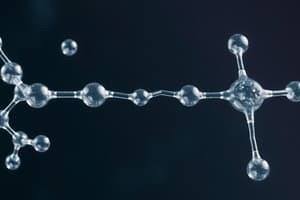Podcast
Questions and Answers
Which of the following accurately describes the role of carbohydrates in living organisms?
Which of the following accurately describes the role of carbohydrates in living organisms?
- They are primarily involved in the formation of nucleic acids.
- They are solely responsible for cellular structure.
- They serve as a source of stored chemical energy. (correct)
- They provide insulation against heat loss.
What distinguishes monosaccharides from disaccharides?
What distinguishes monosaccharides from disaccharides?
- Monosaccharides are composed of two sugar units.
- Disaccharides do not contain any sugar units.
- Disaccharides can only be derived from polysaccharides.
- Monosaccharides are single unit sugars while disaccharides contain two sugar units. (correct)
Which of the following examples represents an oligosaccharide?
Which of the following examples represents an oligosaccharide?
- Cellulose
- Sucrose
- Glucose
- Raffinose (correct)
What is the common function of polysaccharides in organisms?
What is the common function of polysaccharides in organisms?
Which of the following best defines the structural characteristics of carbohydrates?
Which of the following best defines the structural characteristics of carbohydrates?
Which carbohydrate is classified as a monosaccharide?
Which carbohydrate is classified as a monosaccharide?
How are disaccharides formed?
How are disaccharides formed?
What is the primary chemical composition of carbohydrates?
What is the primary chemical composition of carbohydrates?
Which of the following best describes carbohydrates as biomolecules?
Which of the following best describes carbohydrates as biomolecules?
Flashcards are hidden until you start studying
Study Notes
Carbohydrates Importance
- Carbohydrates are crucial for life, providing energy through oxidation.
- Carbon from carbohydrates is used to build cell components.
- They act as a stored energy source.
- Carbohydrates form part of the structure of cells and tissues.
- Carbohydrates are biomolecules.
Carbohydrate Definition
- Carbohydrates, also called saccharides, are polyhydroxy aldehydes or ketones.
- They can break down into these compounds through hydrolysis.
Monosaccharides
- Monosaccharides are the simplest carbohydrates.
- They have a single polyhydroxy aldehyde or ketone unit.
- Examples include glucose and fructose.
Disaccharides
- Disaccharides consist of two monosaccharides linked by a covalent bond.
- An example is sucrose.
Oligosaccharides
- Oligosaccharides contain three to ten monosaccharide units.
- Raffinose is an example.
Polysaccharides
- Polysaccharides contain long chains of hundreds or thousands of monosaccharide units.
- These chains can be straight or branched.
- Examples include cellulose, glycogen, and starch.
Studying That Suits You
Use AI to generate personalized quizzes and flashcards to suit your learning preferences.



